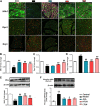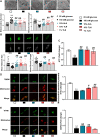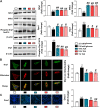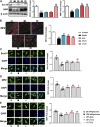Tang Luo Ning, a Traditional Chinese Compound Prescription, Ameliorates Schwannopathy of Diabetic Peripheral Neuropathy Rats by Regulating Mitochondrial Dynamics In Vivo and In Vitro
- PMID: 34054529
- PMCID: PMC8160508
- DOI: 10.3389/fphar.2021.650448
Tang Luo Ning, a Traditional Chinese Compound Prescription, Ameliorates Schwannopathy of Diabetic Peripheral Neuropathy Rats by Regulating Mitochondrial Dynamics In Vivo and In Vitro
Erratum in
-
Corrigendum: Tang Luo Ning, a Traditional Chinese Compound Prescription, Ameliorates Schwannopathy of Diabetic Peripheral Neuropathy Rats by Regulating Mitochondrial Dynamics In Vivo and In Vitro.Front Pharmacol. 2021 Jul 22;12:718452. doi: 10.3389/fphar.2021.718452. eCollection 2021. Front Pharmacol. 2021. PMID: 34366870 Free PMC article.
Abstract
Tang Luo Ning (TLN), a traditional Chinese compound prescription, has been used clinically to treat diabetic peripheral neuropathy (DPN) in China. However, the exact mechanisms remain unclear. The objective of this study is to unravel the effects of TLN on mitochondrial dynamics of DPN in streptozotocin-induced rat models and Schwann cells cultured in 150 mM glucose. Mitochondrial function was determined by Ca2+ and ATP levels of streptozotocin (STZ)-induced DPN rats and mitochondria structure, mitochondrial membrane potential (MMP), and mtDNA of high glucose incubated SCs. Mitochondrial dynamics protein including mitofusin 1 (Mfn1), mitofusin 2 (Mfn2), optic atrophy 1 (Opa1), and dynamin-related protein 1 (Drp1) were investigated using Western blot or immunofluorescence. Myelin basic protein (MBP), myelin protein zero (MPZ), and sex-determining region Y (SRY)-box 10 (Sox10) were measured to represent schwannopathy. Our results showed that TLN increased ATP levels (0.38 of model, 0.69 of HTLN, 0.61 of LTLN, P<0.01; 0.52 of 150 mM glucose, 1.00 of 10% TLN, P<0.01, 0.94 of 1% TLN, P<0.05), MMP (0.56 of 150 mM glucose, P<0.01, 0.75 of 10% TLN, P<0.05, 0.83 of 1% TLN, P<0.01), and mtDNA (0.32 of 150 mM glucose, 0.43 of 10% TLN, P<0.01) while decreased Ca2+ (1.54 of model, 1.06 of HTLN, 0.96 of LTLN, P<0.01) to improve mitochondrial function in vivo and in vitro. TLN helps maintain balance of mitochondrial dynamics: it reduces the mitochondria number (1.60 of 150 mM glucose, 1.10 of 10% TLN, P<0.01) and increases the mitochondria coverage (0.51 of 150 mM glucose, 0.80 of 10% TLN, 0.87 of 1% TLN, P<0.01), mitochondrial network size (0.51 of 150 mM glucose, 0.95 of 10% TLN, 0.94 of 1% TLN, P<0.01), and branch length (0.63 of 150 mM glucose, P<0.01, 0.73 of 10% TLN, P<0.05, 0.78 of 1% TLN, P<0.01). Further, mitochondrial dynamics-related Mfn1 (0.47 of model, 0.82 of HTLN, 0.77 of LTLN, P<0.01; 0.42 of 150 mM glucose, 0.56 of 10% TLN, 0.57 of 1% TLN, P<0.01), Mfn2 (0.40 of model, 0.84 of HTLN, 0.63 of LTLN, P<0.01; 0.46 of 150 mM glucose, 1.40 of 10% TLN, 1.40 of 1% TLN, P<0.01), and Opa1 (0.58 of model, 0.71 of HTLN, 0.90 of LTLN, P<0.01; 0.69 of 150 mM glucose, 0.96 of 10% TLN, 0.98 of 1% TLN, P<0.05) were increased, while Drp1 (1.39 of model, 0.96 of HTLN, 1.18 of LTLN, P<0.01; 1.70 of 150 mM glucose, 1.20 of 10% TLN, 1.10 of 1% TLN, P<0.05), phosphorylated Drp1 (2.61 of model, 1.44 of HTLN, P<0.05; 2.80 of 150 mM glucose, 1.50 of 10% TLN, 1.30 of 1% TLN, P<0.01), and Drp1 located in mitochondria (1.80 of 150 mM glucose, 1.00 of 10% TLN, P<0.05) were decreased after treatment with TLN. Additionally, TLN improved schwannopathy by increasing MBP (0.50 of model, 1.05 of HTLN, 0.94 of HTLN, P<0.01; 0.60 of 150 mM glucose, 0.78 of 10% TLN, P<0.01, 0.72 of 1% TLN, P<0.05), Sox101 (0.41 of model, 0.99 of LTLN, P<0.01; 0.48 of 150 mM glucose, 0.65 of 10% TLN, P<0.05, 0.69 of 1% TLN, P<0.01), and MPZ (0.48 of model, 0.66 of HTLN, 0.55 of HTLN, P<0.01; 0.60 of 150 mM glucose, 0.78 of 10% TLN, P<0.01, 0.75 of 1% TLN, P<0.05) expressions. In conclusion, our study indicated that TLN's function on DPN may link to the improvement of the mitochondrial dynamics, which provides scientific evidence for the clinical application.
Keywords: Drp1; Mfn1; Mfn2; OPA1; Schwann cells; diabetic peripheral neuropathy; mitochondrial dynamics.
Copyright © 2021 Zhu, Yang, Li, Han, Zhu and Xu.
Conflict of interest statement
The authors declare that the research was conducted in the absence of any commercial or financial relationships that could be construed as a potential conflict of interest.
Figures





Similar articles
-
Corrigendum: Tang Luo Ning, a Traditional Chinese Compound Prescription, Ameliorates Schwannopathy of Diabetic Peripheral Neuropathy Rats by Regulating Mitochondrial Dynamics In Vivo and In Vitro.Front Pharmacol. 2021 Jul 22;12:718452. doi: 10.3389/fphar.2021.718452. eCollection 2021. Front Pharmacol. 2021. PMID: 34366870 Free PMC article.
-
Mechanism of Tang Luo Ning effect on attenuating of oxidative stress in sciatic nerve of STZ-induced diabetic rats.J Ethnopharmacol. 2015 Nov 4;174:1-10. doi: 10.1016/j.jep.2015.07.047. Epub 2015 Aug 5. J Ethnopharmacol. 2015. PMID: 26254599
-
Effects of Tang Luo Ning on diabetic peripheral neuropathy in rats revealed by LC-MS metabolomics approach.Biomed Chromatogr. 2022 Jul;36(7):e5374. doi: 10.1002/bmc.5374. Epub 2022 Mar 30. Biomed Chromatogr. 2022. PMID: 35302257
-
Structure, function, and regulation of mitofusin-2 in health and disease.Biol Rev Camb Philos Soc. 2018 May;93(2):933-949. doi: 10.1111/brv.12378. Epub 2017 Oct 25. Biol Rev Camb Philos Soc. 2018. PMID: 29068134 Free PMC article. Review.
-
Therapeutic potential of targeting mitochondrial dynamics in cancer.Biochem Pharmacol. 2020 Dec;182:114282. doi: 10.1016/j.bcp.2020.114282. Epub 2020 Oct 12. Biochem Pharmacol. 2020. PMID: 33058754 Review.
Cited by
-
Paeoniflorin Upregulates Mitochondrial Thioredoxin of Schwann Cells to Improve Diabetic Peripheral Neuropathy Indicated by 4D Label-Free Quantitative Proteomics.Oxid Med Cell Longev. 2022 Mar 18;2022:4775645. doi: 10.1155/2022/4775645. eCollection 2022. Oxid Med Cell Longev. 2022. PMID: 35340203 Free PMC article.
-
Regulatory Effects of Astragaloside IV on Hyperglycemia-Induced Mitophagy in Schwann Cells.Evid Based Complement Alternat Med. 2022 Jan 11;2022:7864308. doi: 10.1155/2022/7864308. eCollection 2022. Evid Based Complement Alternat Med. 2022. PMID: 35069769 Free PMC article.
-
Clinical efficacy of Chinese herbal footbath plus traditional Chinese medicine decoction in diabetic peripheral neuropathy.Am J Transl Res. 2023 Apr 15;15(4):2911-2917. eCollection 2023. Am J Transl Res. 2023. PMID: 37193186 Free PMC article.
-
Plasma exosomes improve peripheral neuropathy via miR-20b-3p/Stat3 in type I diabetic rats.J Nanobiotechnology. 2023 Nov 24;21(1):447. doi: 10.1186/s12951-023-02222-5. J Nanobiotechnology. 2023. PMID: 38001489 Free PMC article.
-
Tang Bi formula alleviates diabetic sciatic neuropathy via AMPK/PGC-1α/MFN2 pathway activation.Sci Rep. 2025 Jul 11;15(1):25069. doi: 10.1038/s41598-025-10513-0. Sci Rep. 2025. PMID: 40646155 Free PMC article.
References
-
- Agarwal N., Taberner F. J., Rangel Rojas D., Moroni M., Omberbasic D., Njoo C., et al. (2020). SUMOylation of Enzymes and Ion Channels in Sensory Neurons Protects against Metabolic Dysfunction, Neuropathy, and Sensory Loss in Diabetes. Neuron 107, 1141–1159. 10.1016/j.neuron.2020.06.037 - DOI - PubMed
LinkOut - more resources
Full Text Sources
Other Literature Sources
Research Materials
Miscellaneous

